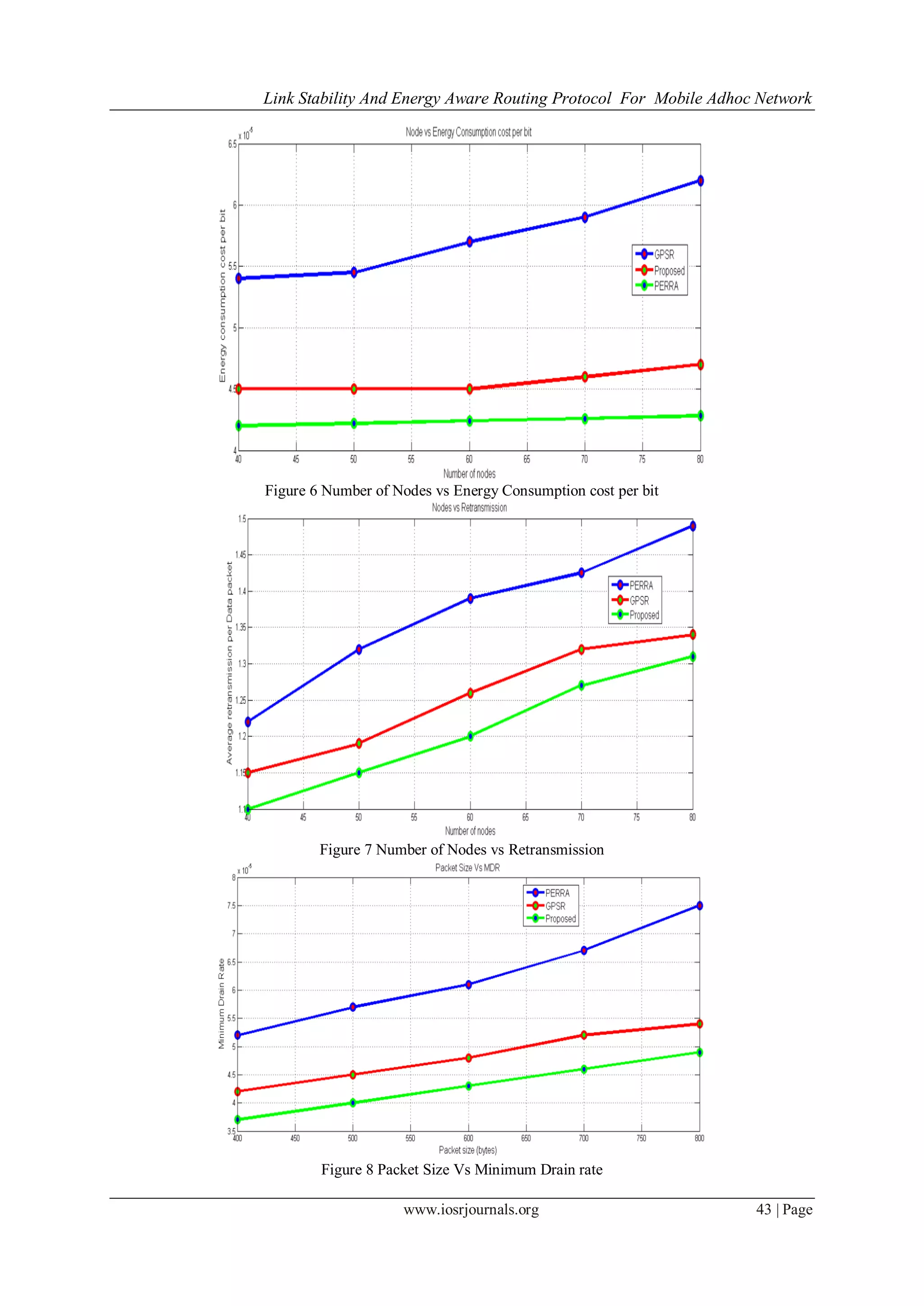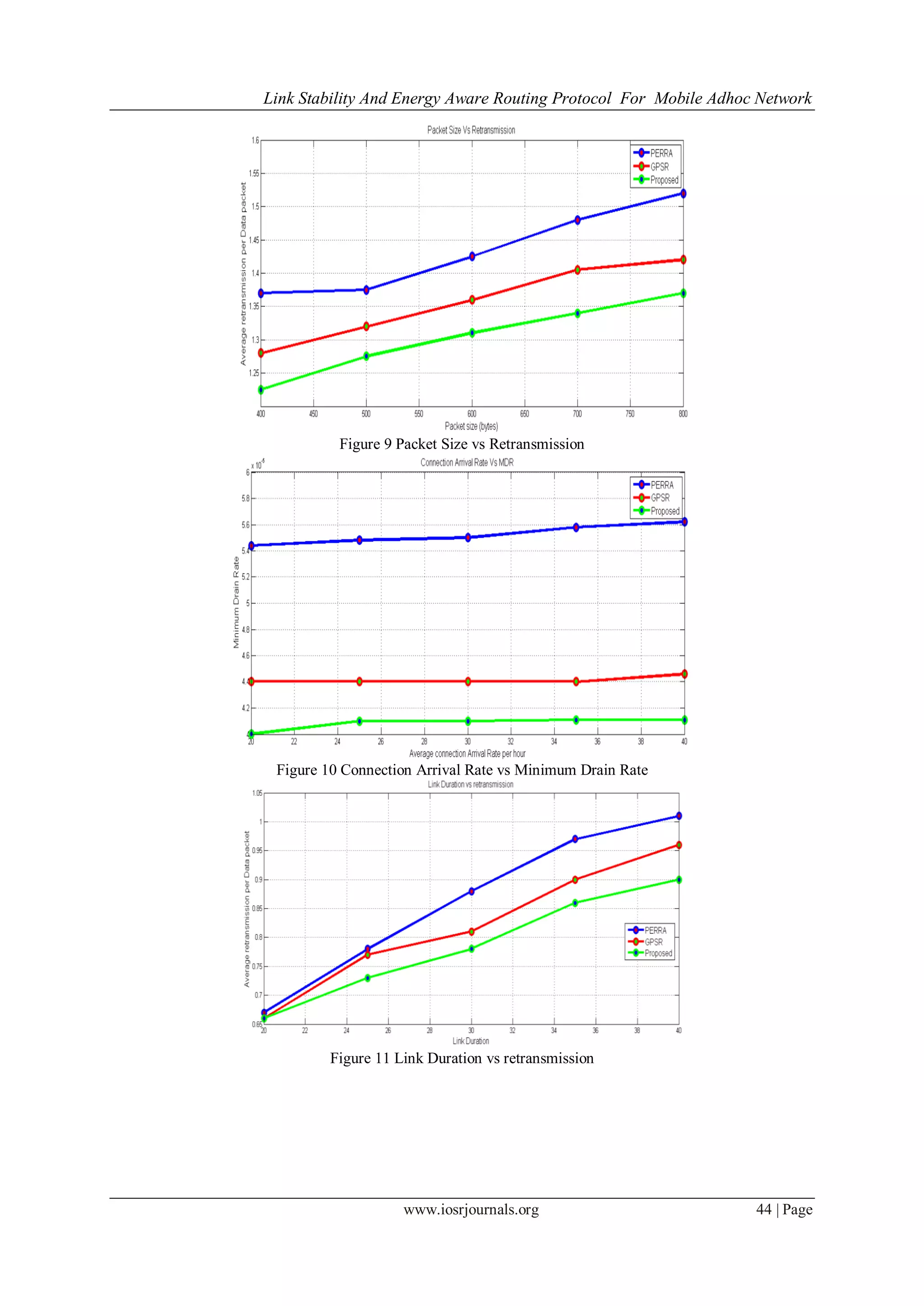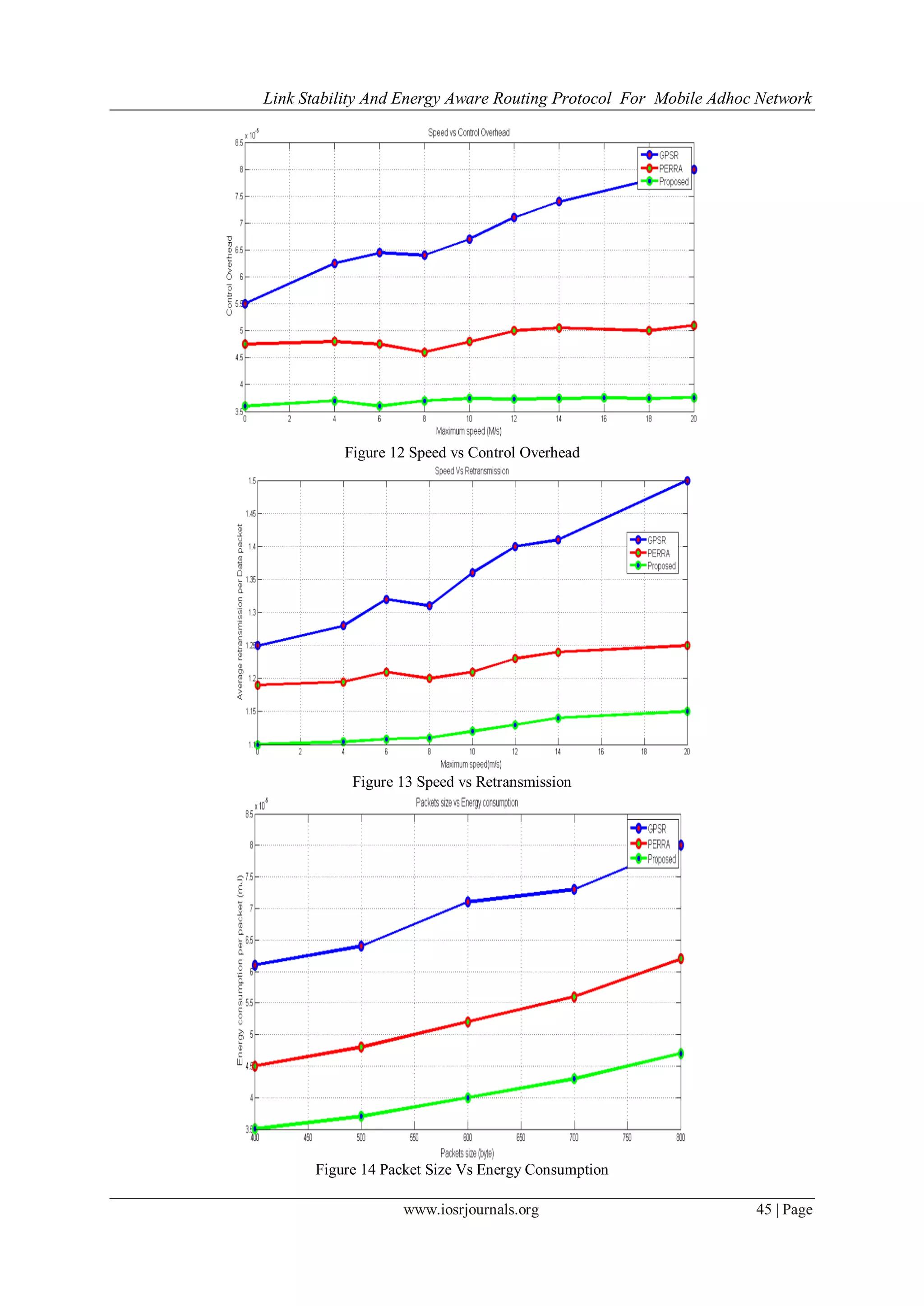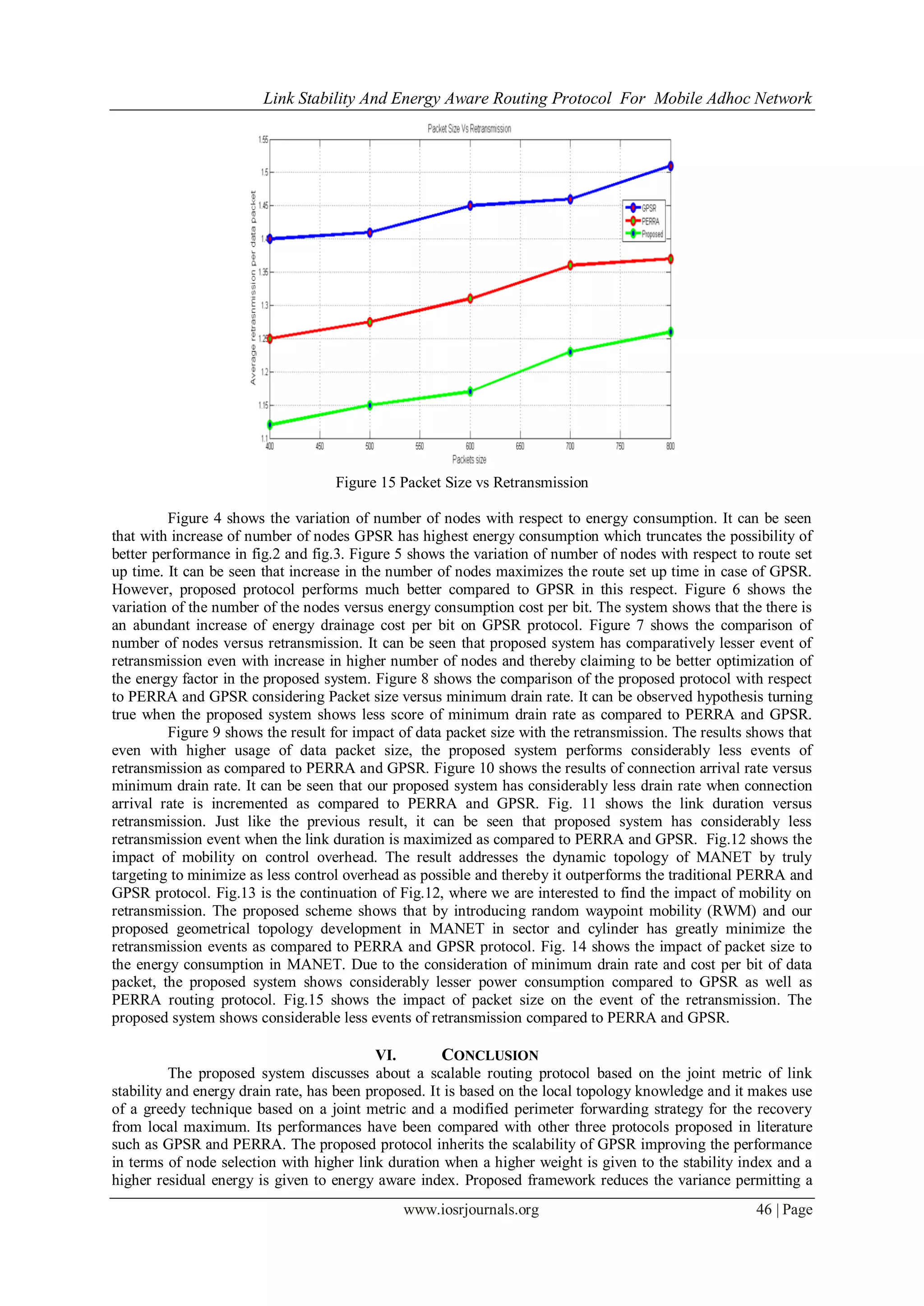The document describes a proposed Link-Stability and Energy Aware Routing Protocol for Mobile Ad Hoc Networks. The protocol aims to jointly optimize link stability and energy consumption. It uses a novel stability metric based on residual link lifetime that is independent of transmission parameters. It also introduces an energy-aware metric that considers residual energy and its variation over time. The protocol is implemented using a greedy forwarding technique to select the next hop, minimizing an energy-stability metric. It is evaluated against other protocols through simulations to test performance on metrics like energy consumption, path duration, and packet delivery ratio.
![IOSR Journal of Electronics and Communication Engineering (IOSR-JECE)
e-ISSN: 2278-2834,p- ISSN: 2278-8735.Volume 6, Issue 4(May. - Jun. 2013), PP 37-47
www.iosrjournals.org
www.iosrjournals.org 37 | Page
Link Stability and Energy Aware routing Protocol for Mobile
Adhoc Network
Pradeep Gowda.B.S1,
Dr.H.Saroja Devi2
1 Mtech Scholar, CSE, NMIT, Bangalore, India
2 Professor, Dept of computer science and engineering, NMIT, Bangalore
Abstract: MOBILE ad hoc networks (MANETs) have more popularity among mobile network devices and
wireless communication technologies. A MANET is multihop mobile wireless network that have neither a fixed
infrastructure nor a central server. Every node in a MANET will act as a router, and also communicates with
each other. The mobility constraints in mobile nodes will lead to problems in link stability. Energy saving, path
duration and stability will be two major efforts and to satisfy them can be difficult task. A self node which is
present in the network may also consume little energy during the transmission. This proposed approach tries to
account for link stability and for minimum drain rate energy consumption. In order to verify the correctness of
the proposed solution a objective optimization formulation has been designed and a novel routing protocol
called Link-Stability and Energy aware Routing protocols is proposed. This novel routing scheme has been
compared with other two protocols: PERRA and GPSR. The protocol performance has been evaluated in terms
of Data Packet Delivery Ratio, Normalized Control Overhead, Link duration, Nodes lifetime, and Average
energy consumption.
Keywords-component; Energy Consumption, Link Stability, Routing, Self node
I. INTRODUCTION
Energy is important in order to improve the efficiency and life time of the network. When we are
offering more stability under the node mobility will leads to selection of shorter routes. This shortest path may not
be suitable in all the cases, because the selection of shortest path will optimize the energy and can leads to
selection of more fragile node. Our model will minimize the energy consumption and maximize the link stability.
The link stability probability is based on the random probability. Energy is important in order to extend
the life time of the network. Link and path stability among the nodes can offer more benefits in terms of energy
saving over MANET. The Description of some works related to link stability, energy metrics, and their respective
protocols was given in this section [1] [2] [3] [4] [5] [6] [7] [8] [9]. The aim of energy-aware routing protocols is
to reduce energy consumption in transmission of packets between a source and a destination, to avoid routing of
packets through nodes with low residual energy, to optimize flooding of routing information over the network and
to avoid interference and medium collisions. Many energy efficient routing protocol proposals were originally
studied for sensor networks, where the limited energy of nodes is a strong constraint; in MANET, however, the
requirements are different: a node has generally more hardware resources (capable of better performance, but
consuming more energy) and the protocol must preserve the resources of every node in the network (not only a
subset of them, because each node can be, at any time, source or destination of data). A single node failure in
sensor networks is usually unimportant if it does not lead to a loss of sensing and communication coverage; ad-
hoc networks, instead, are oriented towards personal communication and the loss of connectivity to any node is
significant.
In the routing protocol design of mobile nodes, many issues need to be considered in order to offer many
important properties such as scalability, QoS support, security, low power consumption and so on. In this chapter
we focus on the energy issues facing some important aspects going from the energy model definition for the
computation of the energy consumption to energy-aware metrics definition and routing protocol design. If a
network composed of mobile nodes communicating using a wireless radio and where each node can communicate
with each other using the other mobile nodes as relay nodes is applied in a communication system, many
challenging design issues need to be addressed. MANET technology became, in the last years, more commercial
in comparison with the past where it was used for military purpose and this implies more additional features to
offer to the end user with particular reference to quality of service, security and to node lifetime duration. In this
chapter energy saving techniques at network layer and the routing strategies that allow better energy expenditure
and load distribution in order to prolong the network lifetime are considered. After defining a simple energy
consumption model to use as reference for the protocol performance evaluation and after introducing some well-
known energy based metric, some routing protocols belonging to different families of routing strategies are
briefly presented. Section 2 discusses about related work, section-3 discusses about proposed system followed by](https://image.slidesharecdn.com/g0643747-150319044747-conversion-gate01/75/Link-Stability-and-Energy-Aware-routing-Protocol-for-Mobile-Adhoc-Network-1-2048.jpg)
![Link Stability And Energy Aware Routing Protocol For Mobile Adhoc Network
www.iosrjournals.org 38 | Page
implementation in Section-4. Section-5 discusses about result being accomplished and finally some concluding
remarks are made in Section-6.
II. RELATED WORK
A. Mobility – Induced error on Geography Routing in MANET
In Geographic routing, the packet forwarding technique was solely based on the location information of
neighbors [10]. Geographic routing in GPRS consists of two forwarding modes. i) Greedy packet forwarding, ii)
Perimeter forwarding. Initially the packet was forwarded by greed forwarding in which all the nodes were
identified the location based on the neighbor nodes. The packet forwarding mode has been changed in to
perimeter forwarding mode when the node was found out the maximum location Final Stage.
B. Routing Protocols for MANET using Mobility Prediction
In the MANET the nodes can construct a path in the network using the routing capacity of the
intermediate nodes. The communication was established in wireless multi-hop fashion. In other words the
communication is established in a wireless multi-hop fashion. The node can also have other characteristics such
as small size and battery powered, making the node not only mobile but also portable [11]. As a result MANET
can operate in places and situations where traditional networks cannot work properly, such us in disaster recovery
areas, rural zones, and third world countries.
C. Energy Efficient Routing Protocols for MANET
Energy efficient Routing will be the most important Design in MANET. Since mobile nodes are
powered by batteries with limited capacity. Power failures of a mobile node not only affect the node alone, it will
affect the entire network life time [12]. The routing protocols were proposed in MANETs are table-driven and on-
demand driven routing. Routing in MANET includes new generation of on demand routing schemes (AODV,
DSR, TORA, ABR etc) [13].Proactive routing schemes (OSPF, RIP) compute global routes in the background
[14]. The Benefit of proactive routing includes low latency access, alternative paths for effective call acceptance
control. These protocols concentrate on the energy properties scheme of applications.
D. Greedy Perimeter Stateless Routing for MANET
GPRS routing algorithm uses geography to achieve small per node routing state, small routing protocol
message capacity, robust packet delivery etc. GPRS will use immediate neighbor information in forwarding
decisions [15]. Routing protocol will relay on end to end state delivery path between a forwarding router and
packet’s destination.
E. Minimum Energy Mobile Wireless Networks
Position based algorithm is used to maintain the minimum energy between the user. Each user will be
denoted by nodes over two dimensional planes. Each mobile node has a portable transmission set, reception,
processing capabilities [1]. This distributed protocol will find the minimum power topology in the Ad hoc
networks
F. Stable Path Selection
Five Different Metrics have been proposed for stable path selection. The first technique is based on the
local choice of the oldest link as the most stable link; the second class of metrics concerns the selection of the
youngest links, because they are considered more resilient to breakage; the third criterion is based on the selection
of the link with the highest average residual lifetime value; the fourth one makes selection of the link with the
highest persistence probability; finally, the fifth metric focuses on the connection failure probability. The latter
approach has been shown to be robust because it is based on the monitoring of the links lifetime of the mobile
nodes in the wireless network, in the past and in the present, to predict its behavior, in the future without
considering directly parameters depending by underlying mobility model such as node speed or direction. End-to-
end delay of a source destination session is another considered performance metric, particularly for real-time
applications.
Drawbacks of Existing System
The network may contain few self nodes. These nodes will make of CPU power during the transmission from
source node to Destination.
The self node may consume the energy. This is not suitable for energy optimization.
Every node will know about the neighborhood node only,
Route looping can also occur while transmitting the longer packet. This is not suitable for energy
optimization.](https://image.slidesharecdn.com/g0643747-150319044747-conversion-gate01/75/Link-Stability-and-Energy-Aware-routing-Protocol-for-Mobile-Adhoc-Network-2-2048.jpg)
![Link Stability And Energy Aware Routing Protocol For Mobile Adhoc Network
www.iosrjournals.org 39 | Page
III. PROPOSED SYSTEM
The main contributions of the proposed system are the following:
1. A multi-objective mathematical formulation for the joint stability and energy problem is presented.
2. The proposed protocol is based on a geographic paradigm different by other routing protocols accounting for
joint metrics, such as PERRA and GPSR. PERRA [16] is an on-demand routing protocol that provides new
features achieving power efficiency and reliable data transmission. Greedy Perimeter Stateless Routing
(GPSR) [17] is routing protocol for wireless datagram networks that uses the positions of routers and a
packet’s destination to make packet forwarding decisions.
3. Adoption of a novel stability metric based on the residual link lifetime concept. This metric is considered
because it is independent on the transmission radius and node speed parameters that can be affected by
measurement errors.
4. A novel energy aware-metric, adopted in our previous contributions, has been introduced in the proposed
optimization model in order to consider not only the residual energy but also its time variation associated
with the traffic load.
5. The multi-objective routing algorithm is integrated in the scalable routing protocol and its performance is
tested through simulations and comparison with PERRA [16], GPSR [17].
In this study, it is assumed that each wireless node has the capability of forwarding an incoming packet
to one of its neighboring nodes and to receive information from a transmitting node. In addition, each node is able
to identify all its neighbors through protocol messages. It is assumed that each node does not enter in standby
mode and each node can overhear the packet inside its transmission range and it is not addressed to itself.
Node Parameters
Link
Establishment
Euclidean Distance
EnergyMetric
Power
Dissipation
Consumption
cost per bit
Minimum
Drain rate
Residual
Energy
Establish Link Stability
Perform Performance
Evaluation
Perform Comparative
Analysis
Figure 1 Overall Schema of Proposed System
The PROPOSED FRAMEWORK algorithm (See Figure 1) requires each node i to advertise its location
(xi, yi, zi), rate of energy consumption (MDR), and link stability index for each link outgoing by node i. We will
insert the information mentioned above in PROPOSED FRAMEWORK HELLO packet. Each node broadcasts
HELLO packets to all its neighbors that are in its communication range; each node in PROPOSED
FRAMEWORK maintains the table of its direct neighbors. When a node receives the HELLO packet, it updates
the information of the neighbor, if neighbor ID is already present in table or adds neighbor information, if it is a
new neighbor.
The data forwarding strategy of PROPOSED FRAMEWORK is based on a greedy technique such as
GPSR. However, differently by GPSR, the next hop selection tries to minimize the joint energy stability metric.
PROPOSED FRAMEWORK packet forwarding presents high scalability property because only the
neighborhood and destination knowledge are necessary for the greedy technique. The flexibility of energy-
stability-based greedy forwarding is offered through the capability to weight the stability and the energy
consumption on the basis of the interest of the application layer. This means that if an application is more](https://image.slidesharecdn.com/g0643747-150319044747-conversion-gate01/75/Link-Stability-and-Energy-Aware-routing-Protocol-for-Mobile-Adhoc-Network-3-2048.jpg)
![Link Stability And Energy Aware Routing Protocol For Mobile Adhoc Network
www.iosrjournals.org 40 | Page
sensitive to the path stability and, consequently, the link stability, it is possible to give more importance to the si;j
index.
IV. IMPLEMENTATION
The proposed system is implemented in 32 bit Windows OS with 2.84GHz Intel Core-i3 processor with
programming tool Matlab. Figure 1 highlights the architecture of the proposed system that majorly considers
path stability metrics more than link stability metric. The proposed system is classified with energy metric
evaluation and link stability metric which considers mainly the power dissipation factor that frequently alters
with respect to the mobility of the nodes in the simulation area. The system mainly uses greedy approach where
the data packets are forwarded based on the heuristic nature of the energy factors considers. The architecture is
quite flexible for usage of minimum energy consumption even with highest mobility. The proposed system also
exhibits the input entity as mobile node parameters e.g. number of nodes, initialized energy, Euclidean distance
between two nodes, neighborhood nodes etc. The internal process signifies the implementation of PROPOSED
FRAMEWORK protocol that ensures the better and efficient path with minimum energy consumption.
Therefore, the output will result in a energy-aware stabilized path in the proposed system.
Fig.1 also exhibits the that the main process is basically decomposed to sequentially two more sub-
processes termed as Energy aware metric and establishing path stability protocol. Initially, after encapsulating all
the node parameters, a process is designed for initializing energy parameters which leads to generation of power
consumption in transmission and power consumption in receiving. The next process consider the above two data
(Tx_power_Cons and Rx_power_Cons) for evaluating power dissipation and the same is used again for applying
the condition for selection of the neighboring nodes. Once the condition for selection of neighboring nodes are
satisfied, exponential weighted moving average is estimated that finally leads to minimum drain rate estimation.
The energy aware metrics are considered which allows the nodes to perform broadcasting of location,
rate of energy consumption and link stability index value to the neighboring nodes. It is important to point out
that, starting from node i, the generic non-destination neighboring node j can be selected if and only if both the
following conditions are satisfied: i) j has enough energy to receive the information sent from node i, and ii) j is
able (in terms of energy) to transmit the information toward another relay node. The link stability index is
evaluated using path loss exponent, which leads to evaluate the best distance. Greedy heuristics are applied that
finally results in best and robust path exploration with highest value of residual energy of the node present in the
stabilized links. The data forwarding strategy is based on a greedy technique. The next hop selection tries to
minimize the joint energy stability metric. Proposed packet forwarding presents high scalability property because
only the neighborhood and destination knowledge are necessary for the greedy technique. The flexibility of
energy-stability-based greedy forwarding is offered through the capability to weight the stability and the energy
consumption on the basis of the interest of the application layer. This means that if an application is more
sensitive to the path stability and, consequently, the link stability, it is possible to give more importance to the
stability index. On the other hand, an application that needs to prolong the network lifetime and to reduce the
energy consumption also selecting longer route with higher data packet end-to-end delay. The algorithm
responsible for the design is elaborated below:
Algorithm: Algorithm for Configuration and Visualization of Mobile Adhoc Network
Input: Number of nodes
Output: Number of sectors and cylinders
START
1. Initialize R1 as the Transmission range.
2. Initialize number of mobile nodes, velocity.
3. Randomly initialize the Link Stability Index.
4. Design arc using r=[(2*pi)*R1]/number of sectors in mobility area.
5. Estimate Number of Cylinder = (R1/r);
6. Estimate the Angle of Orientation=360/ Number of Sectors in mobility area
7. Calculate number of cylinders
8. For rt=1:m_cyl (t= 0:0.05:6.28)
9. x1 = (x + rt*r*cos(t))';
10. y1 = (y + rt*r*sin(t))';
11.XS1=[x1; x1(1)]; YS1=[y1; y1(1)];
12. Draw Cylinder (XS1, YS1);
13. End
14. Visualize selection of mobile Nodes in simulation area
END
Algorithm: Algorithm for Selection of best path](https://image.slidesharecdn.com/g0643747-150319044747-conversion-gate01/75/Link-Stability-and-Energy-Aware-routing-Protocol-for-Mobile-Adhoc-Network-4-2048.jpg)
![Link Stability And Energy Aware Routing Protocol For Mobile Adhoc Network
www.iosrjournals.org 41 | Page
Input: Number of Nodes, Node location, Residual Energy, Stability index
Output: Selection of best stabilized path.
START
1. Initialize node i and node j
2. IF d (i, j) < R.
3. Link Exist.
4. ELSE
5. Link breakage
6. Estimate Link Life [tfin- tin]
7. Start advertisement using HELLO PACKET
8. HELLO PACKET= [Node_ID, Node_location, Residual Energy, Stability Index]
9. Estimate path-loss exponent
10. Apply Euclidean Distance among nodes with highest residual power.
11. Check for energy dissipation
12. Evaluate the best path in ascending order.
13. Extract the best path based on time of simulation and residual energy.
14. If Current Link Stability index < Minimum Link Stability index
15. Then Current Link Stability index = Minimum Link Stability index
16. Extract best path
END
V. RESULT DISCUSSION
The proposed system is evaluated with respect to PERRA and GPSR routing protocol. PERRA [16] uses
a route discovery procedure through the RREQs propagation that involves just nodes that meet the source’s
energy requirements before transmitting data packets. Data packets are transmitted through the optimum path on
the basis of the minimum residual energy, path stability, and total estimated energy to transmit and process a data
packet. Alternative routes are prepared in case of link break and used before an actual break occurs. Similarly,
GPSR [17] makes greedy forwarding decisions using only information about a router’s immediate neighbors in
the network topology. When a packet reaches a region where greedy forwarding is impossible, the algorithm
recovers by routing around the perimeter of the region. By keeping state only about the local topology, GPSR
scales better in per-router state than shortest-path and ad-hoc routing protocols as the number of network
destinations increases. Under mobility’s frequent topology changes, GPSR can use local topology information to
find correct new routes quickly. The proposed system has considered the similar node parameters for the
comparative performance evaluation of the proposed system with respect to PERRA protocol and GPSR protocol.
The simulation is performed on node number that varies from 50-100 with variation in other node-
determinants too (transmission range, residual energy etc.). Figure 2 highlights the evaluation of the energy
consumption with respect to the flow of the simulation. It can be seen that proposed scheme has less energy
consumption compared to PERRA protocol. However, usage of GPSR using the same simulation environment
proved the best energy restoration with respect to node energy conservation. Figure 3 shows the trends of packet
delivery ratio where it can be seen that although GPSR has highest packet delivery ratio, but the proposed system
ensures very smooth packet delivery ratio. In order to ensure the minimum drain rate, the proposed system
ensures the packet delivery ratio that is superior to PERRA protocol but less superior to GPSR protocol.
Figure 2 Evaluation of Energy Consumption](https://image.slidesharecdn.com/g0643747-150319044747-conversion-gate01/75/Link-Stability-and-Energy-Aware-routing-Protocol-for-Mobile-Adhoc-Network-5-2048.jpg)





![Link Stability And Energy Aware Routing Protocol For Mobile Adhoc Network
www.iosrjournals.org 47 | Page
lower dispersion of node energy around the average, because the use of an energy aware metric is able to
consider not only the residual energy but also the drain rate trend and the traffic load on each single node. A
higher traffic load on a specific node implies a higher drain rate and faster energy consumption. This means that
also the energy metric of PROPOSED FRAMEWORK is better than PERRA permitting to discriminate
between nodes with the same residual energy but with different traffic load. The proposed protocol outperforms
PERRA in terms of control overhead and in terms of a higher capability to balance traffic load due to the
minimum drain rate metric included in the joint metric. Moreover, also the average link duration can be longer
in comparison with PERRA and GPSR, due to the capability to better discriminate the node behavior associated
not only with the current node condition but also with the history of link lifetime.
REFERENCES
[1] Floriano De Rango, Francesca Guerriero, Peppino Fazio, “Link Stability and Energy Aware Routing Protocol in Distributed
Wireless Networks”, IEEE Transactions on Parallel and Distributed systems, Vol 23, No 4 , April 2012.
[2] E. Damiani, S.D.C. di Vimercati, S. Paraboschi, and P. Samarati, “Managing and Sharing Servents’ Reputations in P2P Systems,”
IEEE Trans. Knowledge and Data Eng., vol. 15, no. 4, pp. 840-854, July/Aug. 2003.
[3] F. De Rango et al., “OLSR versus DSR: A Comparative Analysis of Proactive and Reactive Mechanisms from an Energetic Point
of View in Wireless Ad Hoc Networks,” Computer Comm. J., vol. 31, pp.3843-3854, Oct. 2008.
[4] G. Ding and B. Bhargava, “Peer-to-Peer File-Sharing over Mobile AdHoc Networks,” Proc. IEEE Ann. Conf. Pervasive
Computing and Comm. Workshops, pp. 104-108, 2004.
[5] L. Feeney and M. Nilsson, “Investigating the Energy Consumption of a Wireless Network Interface in an Ad Hoc Networking
Environment,” Proc. IEEE INFOCOM, pp. 1548-1557, 2001
[6] L.M. Feeney, “Energy Efficient Communication in Ad Hoc Wireless Networks,” technical report, Swedish Inst. of Computer
Science (SICS), Draft Chapter, 2004.
[7] L. Feeney and M. Nilsson, “Investigating the Energy Consumption of a Wireless Network Interface in an Ad Hoc Networking
Environment,” Proc. IEEE INFOCOM, pp. 1548-1557, 2001.
[8] D. Hales, “From Selfish Nodes to Cooperative Networks – Emergent Link-Based Incentives in Peer-to-Peer Networks,” Proc.
IEEE Int’l Conf. Peer-to-Peer Computing, pp. 151-158, 2004.
[9] Kashyap Balakrishnan, Jing Deng, Pramod K. Varshneym, “TWOACK: Preventing Selfishness in Mobile Ad Hoc Networks”,
Proc. IEEE Ann. Conf. Pervasive Computing and Comm. Workshops, pp. 104-108, 2005.
[10] S. Lindsey, K. Sivalingam, and C.S. Raghavendra, “Power Optimization in Routing Protocols for Wireless and Mobile Networks,”
Handbook of Wireless Networks and Mobile Computing, I. Stojmenovic, ed., Wiley, 2001.
[11] Mei Lim, Wang-Chien Lee an and Sivasubramaniam, “Efficient Peer-to-Peer Information Sharing over Mobile Ad Hoc
Networks”Proc. IEEE Int’l Conf. Peer-to-Peer Computing, pp. 151-158, 2009
[12] L. Schrage, Optimization Modeling with LINGO. Lindo Publishing, 2003.
[13] C. Taddia, A. Giovanardi, G. Mazzini, and M. Zorzi, “Energy Efficient Unicast Routing Protocols over 802.11b,” Proc. IEEE
Global Telecomm. Conf. (GLOBECOM ’05), pp. 555-560, Nov. /Dec. 2005.
[14] Takahiro Hara and Sanjay K. Madria, “Data Replication for Improving Data Accessibility in Ad Hoc Networks”, Proc. IEEE Int’l
Conf. Peer-to-Peer Computing, pp. 161-168, 2004
[15] Q. Zhao and L. Tong, “Energy Efficiency of Large-Scale Wireless Networks: Proactive versus Reactive Networking,” IEEE J.
Selected Areas in Comm., vol. 23, no. 5, pp. 1100-1113, May 2005.
[16] Kyung-Sup Kwak, Kyoung-Jin Kim, Sang-Jo Yo, Power Efficient Reliable Routing Protocol for Mobile Ad-hoc Networks, IEEE
2004
[17] Brad Karp, H. T. Kung, GPSR: Greedy Perimeter Stateless Routing for Wireless Networks, Mo
[18] biCom 2000](https://image.slidesharecdn.com/g0643747-150319044747-conversion-gate01/75/Link-Stability-and-Energy-Aware-routing-Protocol-for-Mobile-Adhoc-Network-11-2048.jpg)